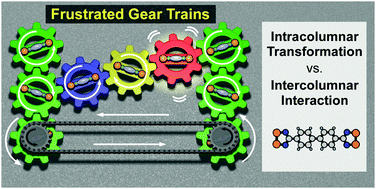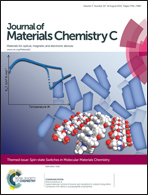Spatially inhomogeneous, stepwise phase transitions in a thiazyl diradical: a structural mismatch induced by lattice transformation†
Abstract
A heterocyclic thiazyl diradical, bis(1,2,3,5-dithiadiazolyl)-4,4′-biphenylene (1), was synthesized, and its structural and thermodynamic properties were characterized. This compound exhibits unique spatially inhomogeneous, first-order phase transitions at 306 and 359 K, in a stepwise fashion. The unit cell in the high-temperature phase above 359 K consists of four regular π-stacking columns with the same stacking manners having a uniform interplanar distance d. These four columns are connected by intermolecular S⋯S and S⋯N contacts between the thiazyl radical moieties, but the molecular planes are shifted by a distance of d/4 due to a steric hindrance between the bulky biphenylene moieties. Below 359 K, three of the four stacking columns exhibit structural transitions toward zigzag chain structures, formed by an alternating dimerization between the radical moieties, while one column maintains the uniform π stacking. In the low-temperature phase below 306 K, the last column finally exhibits the radical dimerization toward a zigzag chain structure. These unique phase transitions in 1 can be understood in terms of the stepwise transitions from a “dimer liquid” to a “dimer solid” through a “dimer soliton phase”.

- This article is part of the themed collection: Spin State Switches in Molecular Materials Chemistry

 Please wait while we load your content...
Please wait while we load your content...